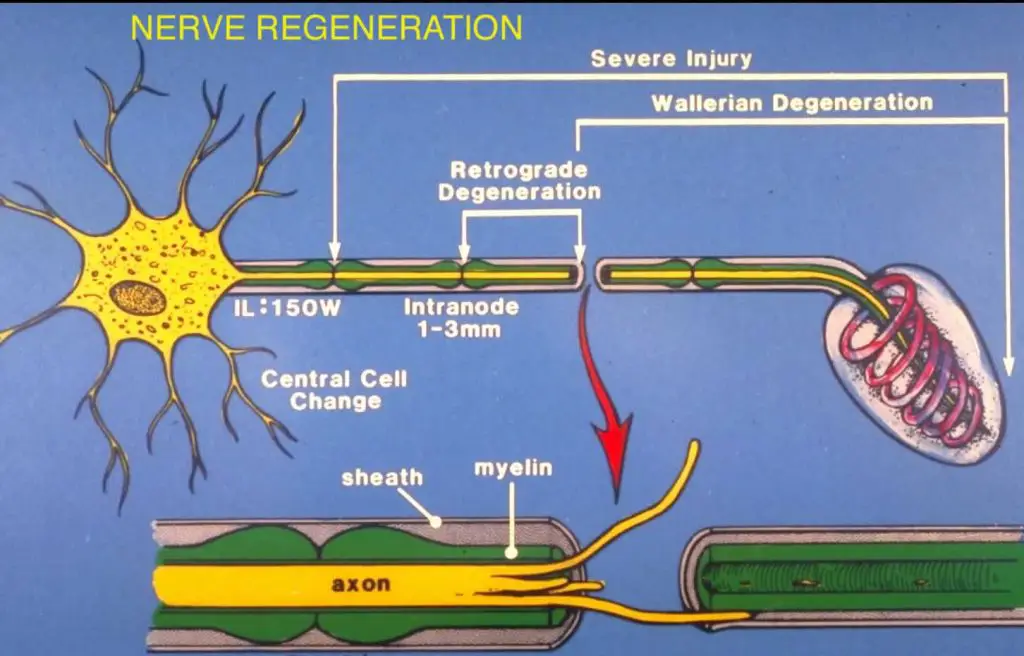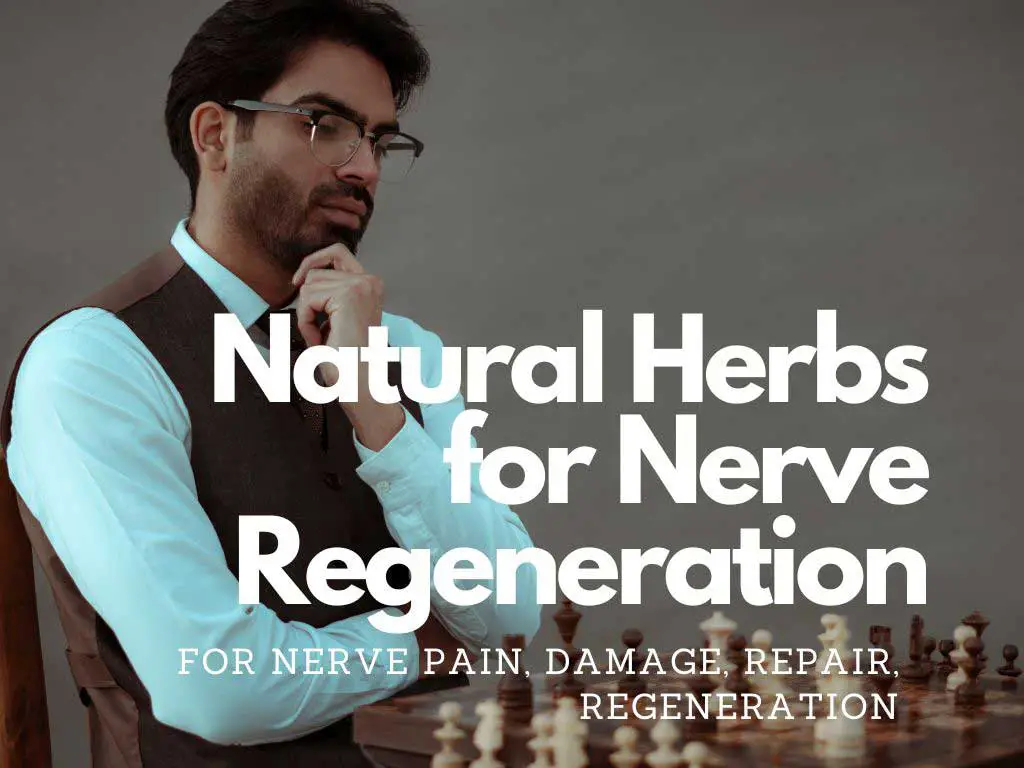What is Nerve Regeneration?
Nerve regeneration occurs when there is repair or regrowth to either the peripheral nervous system (nerves outside the brain and spinal cord) or the central nervous system (brain and spinal cord). Nerve regeneration can refer to the smaller components of a nerve cell, like axons and dendrites, as well as larger nerve tissues. Nerve damage can result from a variety of sources, including injury, disease (e.g. diabetes, cancer, hereditary conditions), drugs, alcohol, and nutritional deficiencies. When the peripheral nervous system is damaged, repair and regeneration typically occur quickly and extensively. However, injury to the central nervous system typically leads to little or no nerve regeneration, often resulting in permanent damage, paralysis, or long term neurological disorders.
Supplements to enhance and promote nerve regeneration as well as decrease nerve degeneration have been studied extensively, and many of these supplements are easily available. However, most of those studies are conducted on animals and many require human clinical trials before they are medically recommended to treat nerve related conditions. There is minimal concrete evidence that vitamins alone can treat nerve related conditions, but a diet rich in vitamins does promote healing and repair.

In a hurry?
Here is the Best Nerve Regeneration Supplement on the Market
List of Natural Herbs and Supplements for Nerve Regeneration, Relief and Repair
Lion’s Mane
Lion’s Mane (Hericium erinaceus) is a Malaysian mushroom, and like many mushrooms it has been used for thousands of years for medicinal purposes. Studies show that eating this mushroom reduces the risk of neurodegenerative disease and improves mild cognitive impairment. There are no adverse effects or side effects from ingesting Lion’s Mane, as shown in laboratory tests. However, there are concerns about the mushroom’s cultivation which is largely unregulated and may be a confounding factor on the mushroom’s potency and ingestibility. It is often dried to increase shelf life, but experimental drying of the fungus shows that dried Lion’s Mane loses its ability to stimulate the outgrowth of axons and dendrites. This is our Favorite Lions Mane on the Market.
Palmitoylethanolamide (PEA)
Palmitoylethanolamide has over 350 clinicaly studies done about its efficacy and safety. At least 3 of these studies demonstrate it’s ability to help with nerve pain. One one study PEA demonstarted the ability to “significantly decrease pain intensity in all parients”. This is a list of the Best Pea Supplements on the Market.
Vitamin B
There are many studies on rats and some clinical studies that found vitamin B accelerates nerve regeneration for peripheral injuries. Large amounts of vitamin B also reduces pain associated with nerve damage. A study on vitamin B and the central nervous system shows that high doses of vitamin B reduces neuron injury following temporary ischemia (i.e. inadequate blood supply) to the spinal cord. Vitamin B also protects the nerves during epileptic seizures. This is a list of our Favorite Vitamin B on the Market.
Vitamin C
Most studies regarding the use of vitamin c (i.e. ascorbic acid) are on mice and rats, but the evidence gained from those studies thus far are promising. One study reports that vitamin C may protect neurons from neurodegenerative diseases like Alzheimer’s, Parkinson’s, and Huntington’s, but more research is needed to confirm this. Another study shows that vitamin C is effective in treating Charcot-Marie-Tooth disease, a genetic condition which causes nerve degeneration. This is a list of our Favorite Vitamin C on the Market.
Vitamin E
Vitamin E is a key vitamin during the process of nerve regeneration and slows down nerve damage caused by diabetes. Peripheral nerve damage is shown to improve when treated with vitamin E and pyrroloquinoline quinone. Studies on rats show that vitamin E treatments improves healing in facial nerves. A deficiency in vitamin E can negatively affect normal nerve regeneration. This is a list of our Favorite Vitamin E on the Market.
Magnesium
Magnesium is the fourth most abundant mineral in the body, and it is a crucial mineral for over 300 enzymatic reactions, some of which promote nerve regeneration for peripheral injuries. It causes Schwann cells to promote the regeneration of nerve axons following injury, particularly compression injuries. Most magnesium is ingested from diet via leafy greens, nuts, seeds, and whole grains, but there are supplements available as well. Aside from supplements, biodegradable magnesium filaments were also used to repair nerves with success. Scientists are not quite sure how or why magnesium is effective in treating neurological disorders, but some hypothesize that it goes hand in hand with its anti-inflammatory properties. There are some side effects from magnesium therapy that may occur like nausea, diarrhea, and gastrointestinal problems. This is a list of our Favorite Magnesium on the Market.
Turmeric (Curcumin)
Curcumin is a component of the popular cooking spice turmeric that has been used in the past for its anti-inflammatory properties and to treat nerve pain in tradition Asian medicinal practices. Studies show that is can also be used for neurodegenerative and neuropsychiatric disorders like Alzheimer’s and epilepsy as well as nerve regeneration in sciatic nerve injuries, but these studies warrant further clinical trials. Anecdotal evidence suggests that daily doses (1300 mg) of turmeric can be used to manage the nerve pain associated with fibromyalgia or to treat the inflammation associated with a compressed sciatic nerve. This is a list of our Favorite Curcumin on the Market.
Acetyl-L-Carnitine (ALCAR)
Clinal trails have established ALCAR as a treatment for diabetic neuropathy, and it improves nerve fiber regeneration. Studies of its effectiveness in treating carpal tunnel are promising, but larger clinical trials are necessary. It is used in treating both central and peripheral nervous system ailments and is thought to work by promoting neurite outgrowth. Another study also shows that ALCAR can be used to treat neuropathy induced by chemotherapy. ALCAR supplements (500 mg) 2-4 times daily are anecdotally recommended for treating nerve pain associated with diabetes, but this is not yet confirmed by large scale clinical trials. This is a list of our Favorite ALCAR on the Market.
Fish Oil
Fish oil is thought to treat nerve degeneration in peripheral nerve injuries because it contains long chain omega-3 polyunsaturated fatty acids. Those fatty acids work by reducing inflammation and pain. There is experimental evidence that fish oil can be used to treat central nervous system ailments, including demyelinating disease that causes that damages the myelin sheath that surrounds nerve fibers in your brain, optic nerves, and spinal cord, but further research is needed. Additional research on omega-3 polyunsaturated fatty acids supports that the supplement may help in nerve regeneration and increased nerve density following corneal surgery, but this has only been studied in rabbits thus far. Fish oil might also be useful for treating nerve pain induced by diabetes, as shown in experimental studies on rats. This is a list of our Favorite Fish Oil on the Market.
Folic Acid
Folic acid is a synthetic form of folate, which is essentially vitamin B9, and we know from previous studies that vitamin B is helpful in treating nerve conditions. Studies on rats showed that folic acid improved nerve growth in the tibia, following injury. Folic acid is thought to be a key component for growth and differentiation in the central nervous system during development, and there is further evidence that it might support nerve growth and repair for central nervous system conditions in adults. However, there is a genetic condition caused by over consumption of folate that affects nearly one in six people in the United States that causes nerve damage in older adults. This is a list of our Favorite Clover on the Market.
Forskolin
There is evidence that forskolin stimulates nerve regeneration and increases motor neurons. One study showed that forskolin increased nerve regeneration by 40%. Forskolin works by elevating cyclic adenosine monophosphate (cAMP) levels, and cAMP is involved in nerve cell development and protection. Another way in which forskolin works is by causing the pituitary gland to release electric impulses and release regulatory chemicals. Some people recommend taking twice daily 130 mg tablets in order to treat nerve conditions as well as immunodeficiency issues with nerve related symptoms, but clinical evidence for this is not available yet. This is a list of our Favorite Forskolin on the Market.
Ginger
Zingiber officinale has been used for thousands of years in traditional medicinal practices to treat many ailments, including pain and inflammation. Even though some experimental trails support this, there are mixed results regarding the effectiveness of ginger. Being that ginger is closely related to the turmeric plant, it is expected that they share medicinal properties, however more research on ginger itself needs to be completed. Anecdotal evidence reports that ginger provides some relief from the peripheral pain caused by neuropathy. This is a list of our Favorite Ginger on the Market.
St. John’s Wort
This is a leafy herb named Hypericum perforatum that was first used by the Ancient Greeks through the Middle Ages to treat a variety of conditions, including topical treatments to treat injuries that resulted in nerve damage. Experimental studies show that the flavonoids within St. John’s Wort may actually be effective in treating neurodegenerative ailments like Parkinson’s and Alzheimer’s. St. John’s Wort does however have mild to moderate side effects like dizziness and nausea, and there are some instances of neuropathy and mania caused by St. John’s Wort. St. John’s Wort also interacts with other drugs, so it is best to consult a health care professional before taking St. John’s Wort. This is a list of our Favorite St. John’s Wort on the Market.
Alpha Lipoic Acid
It is thought that because ALA is both fat and water soluble that it can travel and work throughout the body, compared to other supplements that are either fat or water soluble. Because it can travel throughout the body, many think that is what makes ALA more effective at treating conditions like neuropathy as well as protect nerve tissue in the brain as a treatment for strokes and dementia. Studies on rats show that ALA may be helpful in treating peripheral nerve compression injuries, but some scientists still suggest that more research is needed before using it in treating many nerve-related conditions. Since ALA is not a proven treatment, there is no recommended dose, but anecdotal evidence suggests taking anywhere between 600-1200 mg daily to treat diabetic neuropathy and other conditions related to nerve pain. This is a list of our Favorite Alpha Lipoic Acid on the Market.
References:
https://www.ncbi.nlm.nih.gov/pmc/articles/PMC4904479/
https://www.ncbi.nlm.nih.gov/pmc/articles/PMC3506245/
https://www.sciencedirect.com/science/article/pii/B9780128051863000229
https://www.sciencedirect.com/science/article/pii/B9780123813657000108
https://www.ncbi.nlm.nih.gov/pmc/articles/PMC3725125/
https://www.sciencedirect.com/topics/neuroscience/vitamin-c
https://www.ncbi.nlm.nih.gov/pubmed/2078094
https://www.sciencedirect.com/science/article/pii/S1743919113010741
https://www.sciencedirect.com/science/article/pii/S1808869416300453#bib0220
https://www.ncbi.nlm.nih.gov/pubmed/21609904
https://www.ncbi.nlm.nih.gov/pmc/articles/PMC5270442/
https://www.ncbi.nlm.nih.gov/pmc/articles/PMC4586582/
https://www.ncbi.nlm.nih.gov/pmc/articles/PMC2929771/
https://www.ncbi.nlm.nih.gov/pubmed/26552010
https://www.ncbi.nlm.nih.gov/pmc/articles/PMC3924982/
https://www.ncbi.nlm.nih.gov/pubmed/15616239
https://www.ncbi.nlm.nih.gov/pubmed/29089890
https://www.ncbi.nlm.nih.gov/pmc/articles/PMC5259863/
https://www.ncbi.nlm.nih.gov/pmc/articles/PMC2856794/
https://www.ncbi.nlm.nih.gov/pubmed/9915901
https://www.ncbi.nlm.nih.gov/pubmed/15293274
https://www.sciencedaily.com/releases/2016/10/161012141654.htm
https://www.ncbi.nlm.nih.gov/pubmed/25423028
http://onlinelibrary.wiley.com/doi/10.1002/glia.10022/full
https://www.ncbi.nlm.nih.gov/pubmed/22564128
https://www.ncbi.nlm.nih.gov/pubmed/23686612
https://www.ncbi.nlm.nih.gov/books/NBK92775/
https://www.ncbi.nlm.nih.gov/pmc/articles/PMC3307240/
https://www.ncbi.nlm.nih.gov/books/NBK92750/#
https://www.ncbi.nlm.nih.gov/pmc/articles/PMC2939615/
https://www.umm.edu/health/medical/altmed/supplement/alphalipoic-acid





Yes but how do you take these supplements? All at once? Seems like a lot…. is it safe to take all these at once? That would have been very helpful
Hi Shawna,
Definitely don’t take all of these supplements at once! I’d start with the the lions mane product I recommend and go from there. If it doesn’t work, try something else.
Smart comment from Darcy. To piggyback her I think it is a good idea also to introduce yourself to one at a time. Only because if you take them at once and have a reaction. You wouldn’t know which herb gave you the reaction because you took so many. Take one, and if you feel weird or have a reaction, I’d say it’s not for you. Works for me.
Great advice! 🙂
A good mixture of vitamins and minerals and essential oils at optimum level for complete inner health.but which one is for which !?